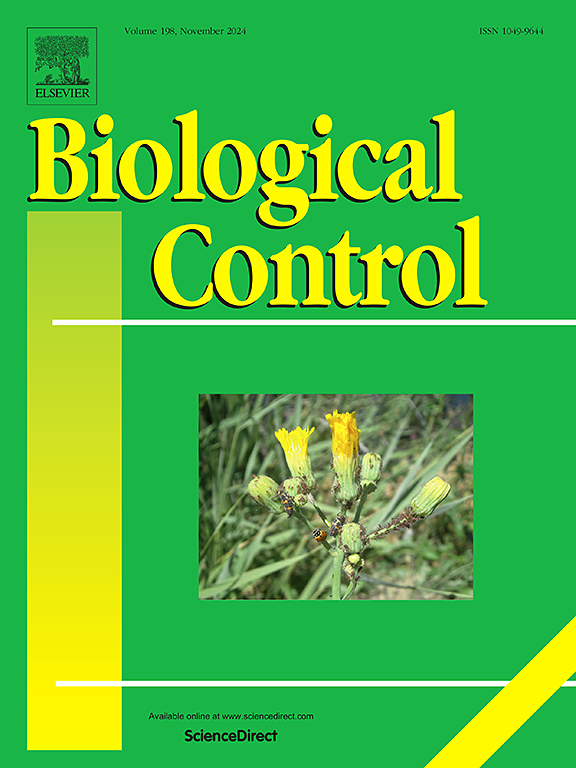Dynamic metabolomic changes in Pochonia chlamydosporia’s parasitism of Parascaris equorum eggs
IF 3.4
2区 农林科学
Q2 BIOTECHNOLOGY & APPLIED MICROBIOLOGY
引用次数: 0
Abstract
Pochonia chlamydosporia, a nematophagous fungus, holds great promise as a biological control agent against animal − parasitic nematodes. However, the molecular and cellular mechanisms of its infection process remain largely unclear. In this study, metabolomics was utilized to investigate the dynamic changes in the exometabolome during the infection of P. chlamydosporia on Parascaris equorum eggs. Three crucial infection stages were selected: early (A1), middle (B1), and late (C1), with control groups of P. chlamydosporia hyphae cultured without eggs (A, B, C). Metabolite extraction was carried out, followed by Liquid Chromatography-Tandem Mass Spectrometry (LC − MS/MS) analysis to identify differentially accumulated metabolites. LC-MS/MS analysis identified 1,185 fungal-derived metabolites, with key players including Ascochalasin (membrane disruptor), Piperine (signal transducer), and 6-methoxygossypol (egg development inhibitor). These metabolites orchestrated dynamic processes: organic acids fueled TCA cycle energy supply during mid-stage infection, sphingolipids mediated membrane fusion in late stages, and alkaloids disrupted host membrane permeability. Pathway analysis revealed stage-specific hubs: alanine-aspartate metabolism dominated early infection for nitrogen acquisition, cAMP signaling peaked in mid-stage to hijack host pathways, and secondary bile acid biosynthesis surged late-stage to degrade eggshells. These findings clarify that P. chlamydosporia coordinates a metabolic cascade—from energy reprogramming to host defense evasion—to complete parasitism, providing novel targets for biocontrol agent development.
衣孢波绒虫寄生马线虫卵的动态代谢组学变化
衣孢子Pochonia chlamydosporia是一种噬线虫真菌,作为一种生物防治动物寄生线虫的药剂具有很大的前景。然而,其感染过程的分子和细胞机制仍不清楚。本研究利用代谢组学方法研究了衣孢假单胞菌侵染马线虫卵过程中外代谢组学的动态变化。选取早期(A1)、中期(B1)和晚期(C1) 3个关键感染阶段,以无卵培养衣孢单胞菌菌丝为对照组(A、B、C)。进行代谢物提取,然后进行液相色谱-串联质谱(LC - MS/MS)分析,鉴定差异积累的代谢物。LC-MS/MS分析鉴定出1185种真菌衍生的代谢物,其中主要成分包括Ascochalasin(膜干扰物)、胡椒碱(信号换能器)和6-甲氧基棉酚(卵发育抑制剂)。这些代谢物协调了动态过程:有机酸在感染中期促进TCA循环能量供应,鞘脂介导晚期膜融合,生物碱破坏宿主膜通透性。途径分析揭示了阶段特异性中心:丙氨酸-天冬氨酸代谢主导了早期感染的氮获取,cAMP信号在中期达到峰值以劫持宿主途径,次生胆汁酸生物合成在后期激增以降解蛋壳。这些发现表明衣原孢子虫协调了从能量重编程到逃避宿主防御再到完全寄生的代谢级联反应,为生物防治剂的开发提供了新的靶点。
本文章由计算机程序翻译,如有差异,请以英文原文为准。
求助全文
约1分钟内获得全文
求助全文
来源期刊

Biological Control
生物-昆虫学
CiteScore
7.40
自引率
7.10%
发文量
220
审稿时长
63 days
期刊介绍:
Biological control is an environmentally sound and effective means of reducing or mitigating pests and pest effects through the use of natural enemies. The aim of Biological Control is to promote this science and technology through publication of original research articles and reviews of research and theory. The journal devotes a section to reports on biotechnologies dealing with the elucidation and use of genes or gene products for the enhancement of biological control agents.
The journal encompasses biological control of viral, microbial, nematode, insect, mite, weed, and vertebrate pests in agriculture, aquatic, forest, natural resource, stored product, and urban environments. Biological control of arthropod pests of human and domestic animals is also included. Ecological, molecular, and biotechnological approaches to the understanding of biological control are welcome.
 求助内容:
求助内容: 应助结果提醒方式:
应助结果提醒方式:


